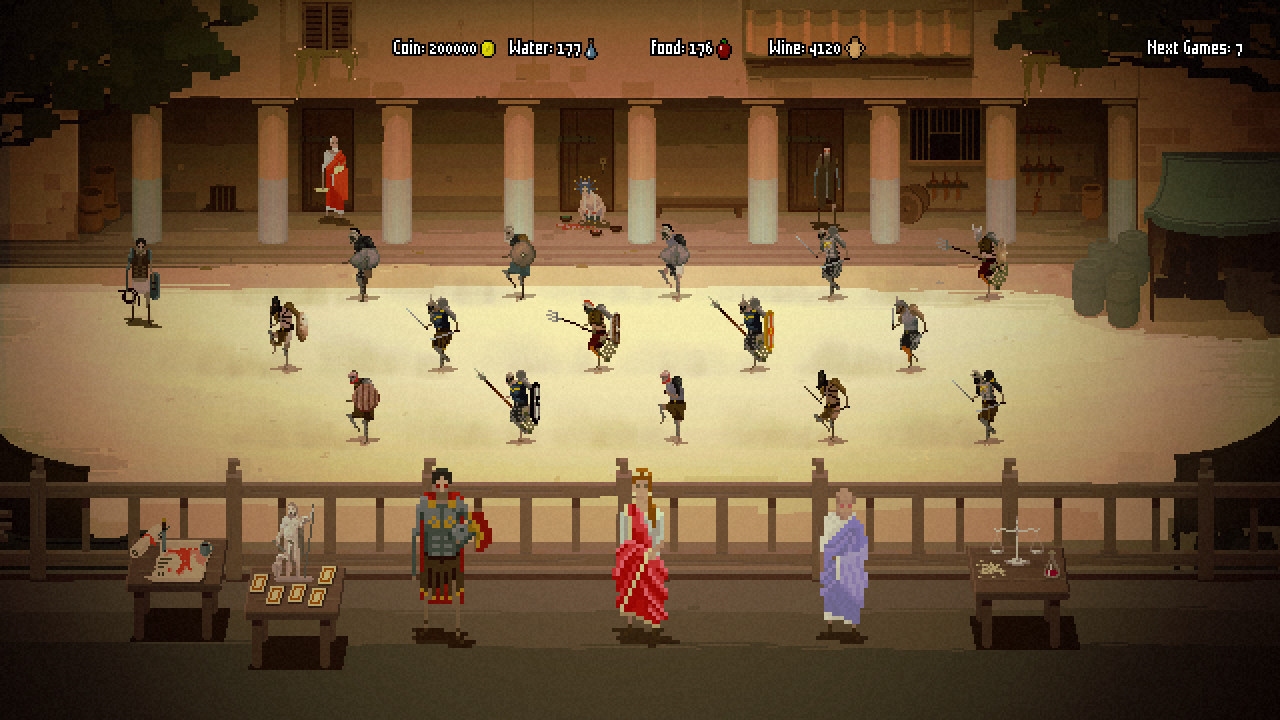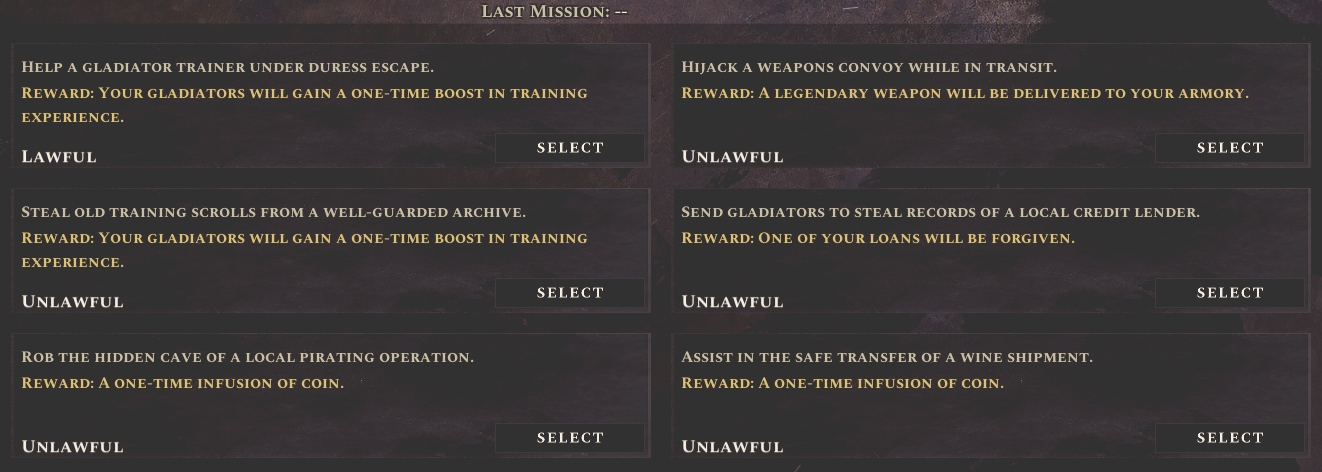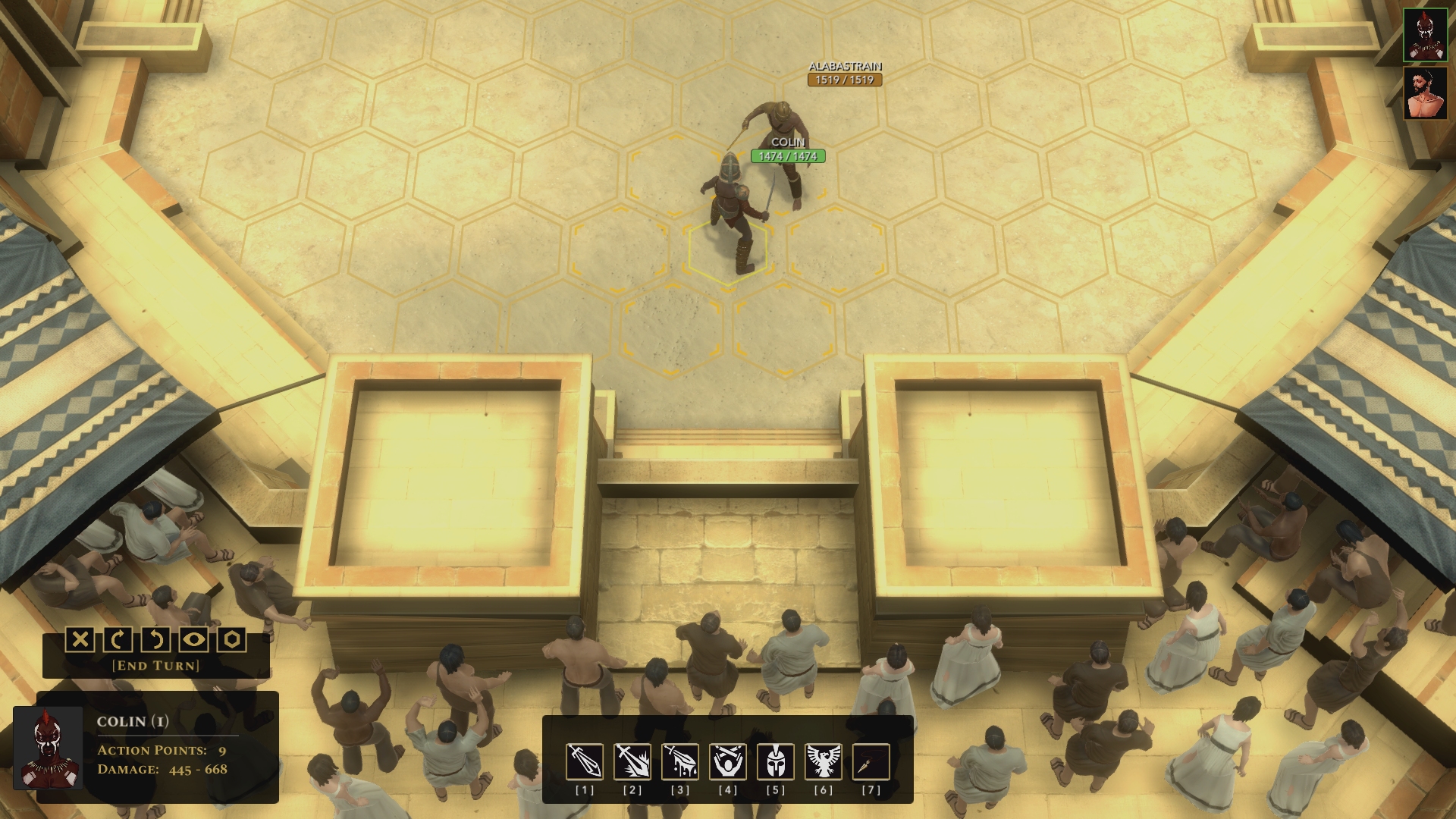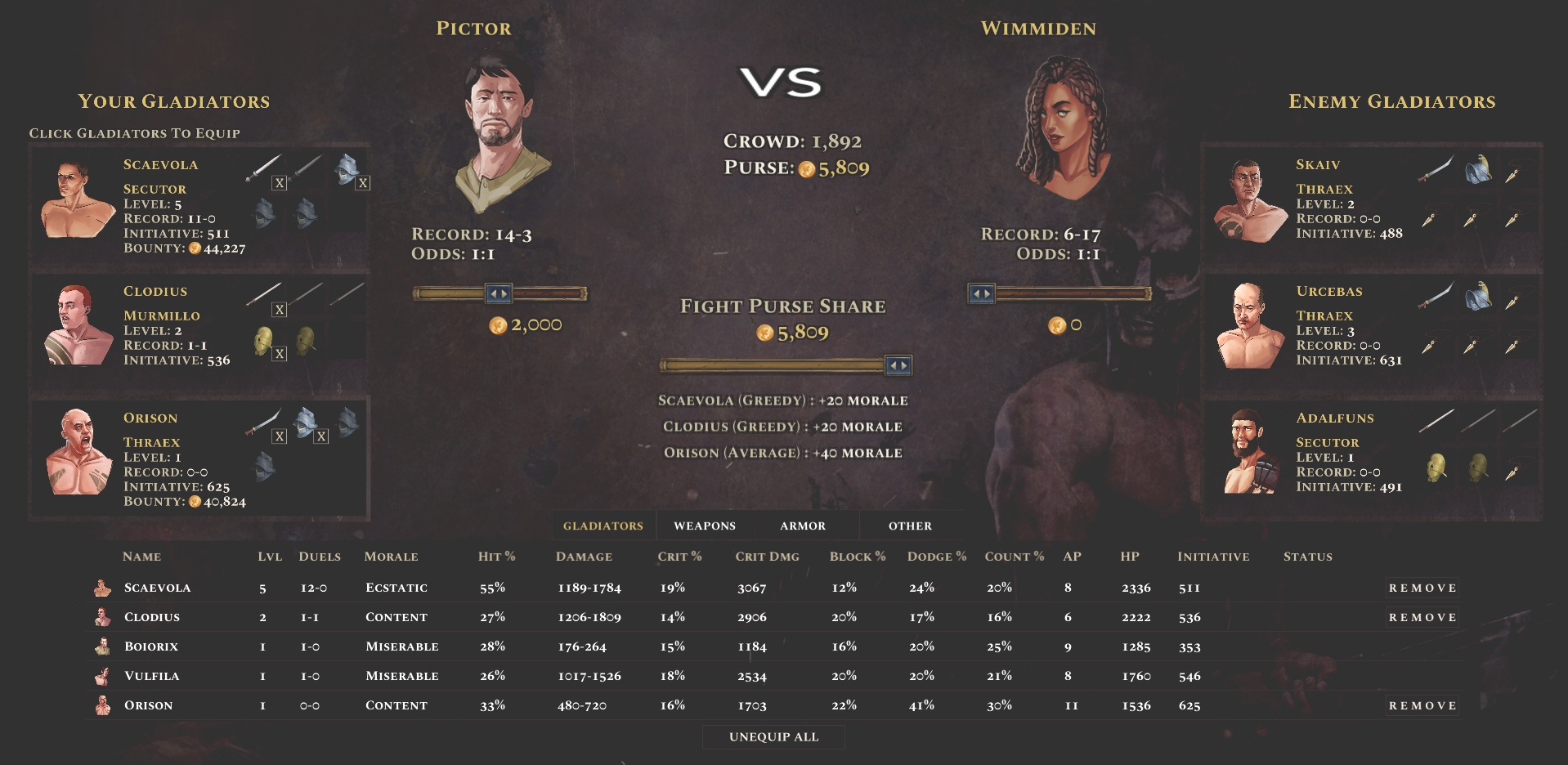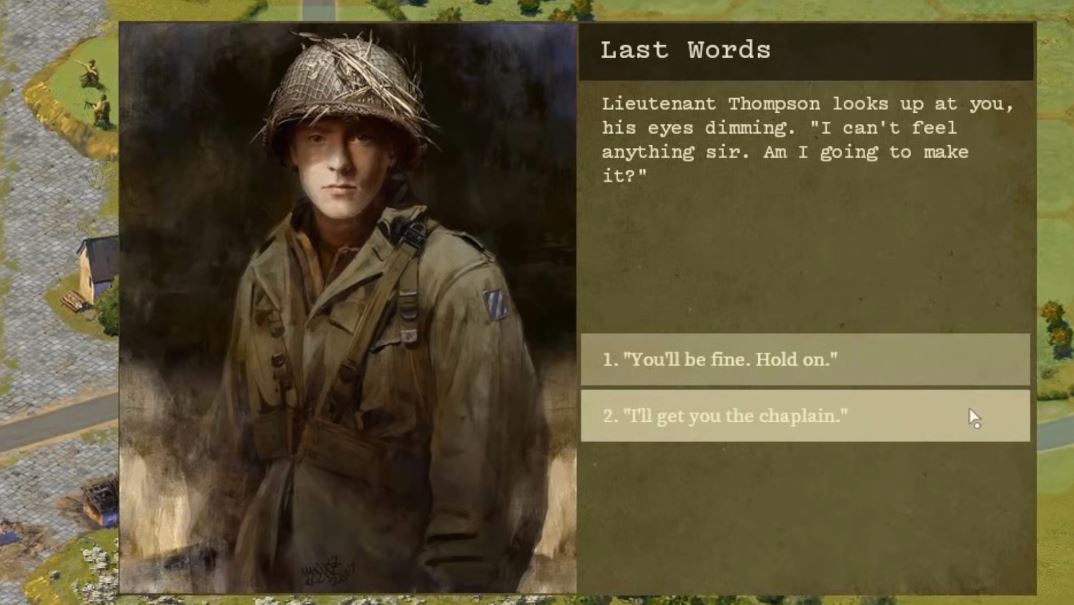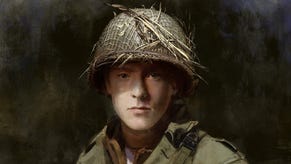The Flare Path: Doubty
Tactical talismans and traumatised testicles
When it comes to modelling courage and its wholly logical antithesis, cowardice, wargame devs are a conservative bunch. A morale test here, a leadership bonus there... why innovate or illuminate when you can follow and fudge. Very few delve into the complex psychology of the warrior as deeply as Green Tree Games, the makers of Burden of Command, or shun the subject with such baffling determination as Creative Storm Entertainment, the folk behind Age of Gladiators II: Rome.
Having found the original Age of Gladiators (pictured above) too dry for my taste and Domina (pictured below) too hectic, I had high hopes for AoG2. A history-steeped gladiator management sim with turnbased strategic and tactical layers, Creative Storm's latest looked, from the hard seats in the maenianum secundum in legneis, like a perfect companion for dear old Qvadriga.
After a day's play I knew better, but wasn't so disenchanted that I instantly abandoned Terry, Barry, Colin and the rest of my bescabbed sword swingers.
It's hard to fault the game's lanista component. Hiring fighters and buying slaves, equipping them, training them, improving your ludus... inter-aggro activities are varied and absorbing if visually underwhelming (there's no graphical representation of your facilities, for example). In addition to your arena artistes you also employ scouts, doctors, trainers and equipment technicians, all of whom come with their own modest sets of influential stats.
Gladiators positively bristle with numbers and traits. The majority determine how likely they are to land blows (or parry or dodge them) and inflict damage, but there are also attributes that bestow character and impact popularity, financial decisions, and extra-curricular activities. The morale of a greedy glad will decrease rapidly unless you're generous when splitting fight purses. A school full of virtuous duelists will seriously restrict your options when it comes to optional side missions, many of which involve skullduggery.
In AoG2's management portion, turns represent single days. As building projects take months to complete and employees don't need constant babysitting, often it's possible to hurry through fightless days without altering anything. Although a lanista has no control over bout timing, format or foes, they do get to select warriors and forfeit scraps - a useful option when opponents look formidable or key fighters are sick or recuperating.
Developing duelists without exhausting, exasperating or extinguishing them is, of course, the name of the game. Chances are, a few hours into your first career you'll find your morgue and hospital overflowing, and your barracks half empty because of escapes and resignations. Whether you restart or soldier on with help from a local moneylender is up to you.
Fame is the primary spur in the long game. Victories and purchased assets like vineyards and seaside villas generate it, eventually allowing you to move to roomier premises in a larger, more fashionable city. As in Football: Tactics and Glory, careers have natural momentum, the promise of success in the next five-minute contest helping to expunge memories of defeat in the last. What a pity the two games are worlds apart when it comes to tactical layer appeal.
Far too often the IGOUGO clashes in AoG2 boil down to fighters standing in adjacent hexagons doggedly slashing the sherbet out of each other. In terms of melee orders there are basically just three, and two of those simply reduce or raise the hit chance in return for increased/reduced damage. If suitably equipped or qualified, gladiators can also use action points to toss blinding handfuls of sand, bolt healing or performance-enhancing herbs, and execute a few other buffs, but once within sword range it's essentially hit and hope, hit and hope, hit and hope, until one party crumples into the dust.
Busier arenas make for slightly more interesting skirmishes. When there are four or more fighters in the mix you need to prioritise and focus, and there are reasons to manoeuvre. It's not nearly enough though. Right now Age of Gladiators 2: Rome is a rich, interesting management sim manacled to an impoverished, dull tactical wargame. Special moves and attacks, courage simulation, dropped weapons, reasons to study an opponent before launching an attack... it's not hard to picture improvements that could, if implemented intelligently, make Age of Gladiators III the game its predecessor really should have been.
Age of Gladiators 2: Rome is available now, priced £14 (£15.50 from August 28th)
* * *
“The dark world of the battlefield is hard to analyze even for those who have been on it. We don’t claim to have the experience right, but we do hope we’re at least interesting about it”. No-one could accuse Luke Hughes, the driving force behind upcoming “tactical leadership RPG” Burden of Command, of overclaiming. Listening to him qualify and downplay, you might not guess that Green Tree's debut title, thanks to a strong reality-rooted narrative and heavy emphasis on psychology, relationships, and characterisation, promises to be one of the most human and thought-provoking tactical wargames yet made.
Burden of Command will bend the truth from time to time, but the manipulation will be done reluctantly and carefully. Luke talked of the game's occasional white lies while walking me through the WIP combat mechanisms at the heart of this recent 'tactical teaser' video:
- - - - Shock Attacks - - - -
Luke: Did you notice that when the StuG appears the GIs immediately show some suppression (Reduction of their morale attribute reducing their effectiveness as their heads go down. It may lead to either panic or ignored orders) despite that fact that no shots were fired. We call this a “shock attack”. Brains and Bullets (also titled War Games: The Psychology of Combat) calls it “weapon push”. The idea is that it is demoralizing to know the other side has weapons you can’t currently match. Here your GIs don’t have armor and the Germans do. Result: suppression. I’ve been told something similar happens when a dragon shows up in Total War: Warhammer! Except for GIs it was for real. Sobering.
There's a nice example of how the Brits got wise to explicitly using shock attacks in WWII in Brains and Bullets. Trooper Brooks, a British soldier, describing the advance into Germany in 1945:
“Before anybody got in range, the Crocodiles would fire off a few jets of flame to let Jerry know what was coming and then they’d walk with the infantry up to the edge of town. Meantime Jerry was having a quick chat about their prospects, and ten-to-one they’d be waving bed sheets before the Crocs got in range. ... Didn’t matter who they were: SS, paratroops, it didn’t matter. Once they’d had the carrot and the stick waved at them, they packed it in. Then we’d all have a brew and a fag before heading off to round up the next lot.”
This kind of morale shock from a mismatch in weaponry has been going on a long time. A quote from the fine WWI treatise Battle Leadership by Captain Adolf Von Schell (later a Panzer Division commander in WWII) who gave talks to the USMC between the wars:
“[WWI: 1916] The Russians had been firing for hours, but our artillery didn’t reply. I went constantly from dugout to dugout to see and speak to my men. They should at least see that they were not alone. Repeatedly they asked me: “Are we really entirely alone here; haven’t we any artillery?” It continued this way for hours. Our telephone wires had been shot to pieces. Finally a tremendous noise came from our rear. Our own artillery was firing. At once high spirits returned.”
But wait, don’t get too hopeful! We’re not going to hand you a lot of flame tanks or you’ll just wipe the floor with our scenarios. The Cottonbalers mostly didn’t have armor support.
- - - - Press and Stress - - - -
Lieutenant Wilson’s squad is “spent”, that is, they have already been ordered for the turn and can’t be given further actions. But now Wilson has a crisis on his hands with a larger German assault heading his way. He responds by “pressing” a squad of his company to give them another action so they can get to cover. But the side effect is long term stress. To be frank, this is a bit Hollywood. Stress psychologically and neurophysiologically comes from continued exposure to threats, especially threats you can do little about). Also from traumatic events like casualties of friends. In the military world we recognize it in its advanced form as shell shock (WWI), combat fatigue (WWII), or PTSD (today). Whether “pressing” stresses... who knows, but it is thematic and puts the player in the position of trading off short term benefit (get the hell out of there) vs long term (stressing troops). We always prioritize a good gameplay experience (otherwise just go read a book!) but we also try not to break history. So stress will be an important part of managing your men. They will accumulate stress mostly from simply being under fire or seeing casualties, but “press” will also generate it directly.
In WWII the US army realized that given enough exposure to combat everyone eventually broke. Unfortunately, for manpower shortage reasons they felt they could typically not rotate infantrymen out of the line (Germans did manage this more BTW). Though they would try to put them on quieter fronts to recover (Ardennes 1944 anyone?). The take away for you in Burden of Command is given enough time and enough exposure of your best officers and squads to combat you will find you have to manage their stress across the campaign (Darkest Dungeon led the way here as well as Dan Verssen's leadership board games). You didn’t think using the best and brightest all the time would come free did you?
The gameplay effect of stress will be that stressed leaders and squads are brittle. They will overreact to threats. Incoming fire that might suppress only two points out of an average 10 morale unit might suppress a stressed unit four points. So experienced but stressed squads and officers become glass cannons requiring careful management. Do it enough and your Lts may ultimately break within the narrative. You have been warned!
- - - - Bolster and Assault - - - -
Lt Thompson is going to lead an assault. He needs to do a short-term pump of their morale (“Follow me!”) to increase the odds that they’ll follow. In gameplay terms “bolster” pumps morale but only for one action. Contrast a “rally” (remember Lt Dearborn facing the German armor?) which achieves a long-term morale boost at the cost of using up the rallied squad for the turn.
Leaders like Dearborn add human drama to combat but really were they that important? The short answer is “very.” One statistical analysis suggests that of their own volition a squad will perhaps assault 20% of the time. After all, who wants to fight hand to hand? In WWI they called it “fear of the bayonet.” A highly trusted leader, whether NCO or officer, can raise this chance to as much as 70%. In game terms, if you order a squad to assault without a “bolster” there's a fair chance that the men “won't quite hear you”. But should you lead by example they’ll likely follow.
Why are Lts doing all the key bolstering when truly it was the NCOs (Corporals, Sergeants etc) who were the Morale backbone? Here we have to plead Hollywood (i.e. game design) again. We focus on key officers to reduce the number of dials you have to turn. We do this not only for simplicity but to increase the chances you’ll empathize with the small band of NPCs who are your “direct reports”.
Some beautiful examples of leadership courage can be found in John McManus’s account of the fighting at Omaha Beach (The Dead and Those About to Die). Beautiful at a distance, but in practice the casualty rates among US junior officers in WWII were shockingly high. “Follow me” comes at a high personal price, a fact reflected in Burden of Command with permadeath.
- - Heroic but Green (or Failing to Obey the Four Fs) - -
There’s a lot to admire in the personal courage of Lt Thompson leading the direct assault on the unsuppressed German MG. Less admirable is the standard of tactical leadership on show. There’s a reason Thompson dies at the end. Assaulting unsuppressed MGs, or even an unsuppressed enemy infantry squad, is an excellent way to perish quickly. In Burden of Command if you lead your men across open ground against an unsuppressed MG you will probably have a short career, your men will likely take very high casualties, and the assault will probably fail. Maybe to get this across in the teaser we should have had exactly that happen. But perhaps that would have been a little too much of a downer for a teaser. Ah hindsight, who can say?
So what should Lt Thompson have done? We couldn’t really give a primer on the “4Fs” in a two-minute video but, for future refrence, it’s: Find, Fix, Flank, and Finish. Specifically, Thompson should have first suppressed (“Fixed”) the German MG with both rifle fire and, assuming they were available, friendly MGs and mortar. After fixing he should then have flanked. Anyone interested in military history knows how important flanking is. Brains and Bullets views it as the single most powerful factor besides leadership and firepower. In Burden of Command terms if you are out of the front arc of the enemy unit when you arrive adjacent, not only will the foe not return fire, but they will suffer a morale check which will likely lead to them surrendering. As an aside, actual hand to hand melees in WWII were relatively rare. That’s why the teaser showed a surrender. It’s so often about morale and not brute force. Fear of the bayonet.
- - - - What’s Missing? - - - -
Of course there are many critical elements of Burden of Command not shown in the teaser. Command Points, “Push Your Luck”, battlefield friction, combined arms tactics, the importance of cover and stance, how troops “habituate” to repeated fire... Perhaps the most important omission is Fog of War. We all know how unpleasant it is in any military game to stumble into an undetected unit. Burden of Command will be no different. FOW was very intense in WWII. GIs were often shocked by the absence of any visible enemy on the battlefield (while still being shot at). Still on the drawing board is whether there will be explicit scouting actions for squads or leaders. We definitely plan for more experienced units to develop a sixth sense (better spotting). Several of the combat experienced vets amongst our team and testers have emphasized that certain individuals really do develop this.
Thanks for letting me prattle on about a subject I am deeply fascinated by - namely, how people react under the deep stress of combat (go listen to some Hardcore History podcasts to hear some amazing real world combat stories). In closing, I want to re-emphasize that first and foremost we want Burden of Command to be an engaging game. We will bend realism and history where we must to achieve that. But we’ll try hard not to break it!
* * *


